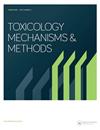表没食子儿茶素-3-没食子酸酯减轻丙烯酰胺诱导的大鼠大脑皮层细胞凋亡和星形胶质细胞形成
IF 2.7
4区 医学
Q2 TOXICOLOGY
引用次数: 34
摘要
摘要丙烯酰胺(acrylamide, ACR)是食品加工过程中美拉德反应产生的强效神经毒性物质。表没食子儿茶素-3-没食子酸酯(EGCG)是绿茶的主要生物活性成分,是一种抗氧化剂,但其对acr诱导的神经毒性的影响尚不清楚。在这里,我们研究了EGCG对acr诱导的大脑皮质细胞凋亡和星形胶质细胞形成的神经保护作用。用EGCG预处理大鼠4 d,再联合ACR治疗14 d。免疫组化分析显示,EGCG能减轻ACR处理大鼠的星形胶质细胞增生和DNA损伤。DNA片段和Bax、Bcl-2、caspase 3、细胞色素c蛋白表达分析显示EGCG抑制acr诱导的细胞凋亡。此外,EGCG通过提高抗氧化酶和谷胱甘肽水平的活性,减少活性氧的形成和脂质过氧化作用来抑制氧化应激。综上所述,我们的数据表明EGCG抑制acr诱导的大脑皮层细胞凋亡和星形胶质细胞形成。本文章由计算机程序翻译,如有差异,请以英文原文为准。
Epigallocatechin-3-gallate attenuates acrylamide-induced apoptosis and astrogliosis in rat cerebral cortex
Abstract The potent neurotoxic agent acrylamide (ACR) is formed during Maillard reaction in food processing. Epigallocatechin-3-gallate (EGCG), a major bioactive component of green tea, is an antioxidant, but its effects on ACR-induced neurotoxicity are unclear. Here, we investigated the neuroprotective effects of EGCG against ACR-induced apoptosis and astrogliosis in the cerebral cortex. Rats were pretreated with EGCG for 4 d and then co-administered ACR for 14 d. Immunohistochemical analysis of glial fibrillary acidic protein and 8-hydroxy-2′-deoxyguanosine indicated that EGCG attenuated astrogliosis and DNA damage in ACR-treated rats. Analysis of DNA fragmentation and protein expression of Bax, Bcl-2, caspase 3, and cytochrome c revealed that EGCG inhibited ACR-induced apoptosis. Furthermore, EGCG inhibited oxidative stress by enhancing the activity of antioxidant enzymes and glutathione levels and reducing the formation of reactive oxygen species and lipid peroxidation. Taken together, our data demonstrate that EGCG inhibits ACR-induced apoptosis and astrogliosis in the cerebral cortex.
求助全文
通过发布文献求助,成功后即可免费获取论文全文。
去求助
来源期刊

Toxicology Mechanisms and Methods
TOXICOLOGY-
自引率
3.10%
发文量
66
期刊介绍:
Toxicology Mechanisms and Methods is a peer-reviewed journal whose aim is twofold. Firstly, the journal contains original research on subjects dealing with the mechanisms by which foreign chemicals cause toxic tissue injury. Chemical substances of interest include industrial compounds, environmental pollutants, hazardous wastes, drugs, pesticides, and chemical warfare agents. The scope of the journal spans from molecular and cellular mechanisms of action to the consideration of mechanistic evidence in establishing regulatory policy.
Secondly, the journal addresses aspects of the development, validation, and application of new and existing laboratory methods, techniques, and equipment. A variety of research methods are discussed, including:
In vivo studies with standard and alternative species
In vitro studies and alternative methodologies
Molecular, biochemical, and cellular techniques
Pharmacokinetics and pharmacodynamics
Mathematical modeling and computer programs
Forensic analyses
Risk assessment
Data collection and analysis.
 求助内容:
求助内容: 应助结果提醒方式:
应助结果提醒方式:


